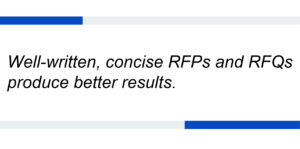In 1961, astronaut Alan Shepard was the first American to go into space and orbit around the Earth for 15 minutes in a Redstone 3 rocket called Freedom 7. After the flight, he said, “It’s a very sobering feeling to be up in space and realize that one’s safety factor was determined by the lowest bidder on a government contract.”
Shepard’s statement is no surprise, as some people have preconceived notions that selecting the lowest bidder will not yield a favorable result. However, the fact that the American space program was an overall success, while sometimes using the lowest bidder, demonstrates that qualifications and an understanding of the client’s needs far outweigh the cost. The success of a project has less to do with using the lowest bidder and more to do with their qualifications and, more importantly, how they arrived at their fee.
 To best determine who can provide the highest quality service at a fair price, one must take a close look at the selection process and the most effective way to write a Request for Proposal (RFP) or a Request for Qualifications (RFQ). The process begins with writing an RFP or RFQ that provides a comparable review of qualified, competing firms.
To best determine who can provide the highest quality service at a fair price, one must take a close look at the selection process and the most effective way to write a Request for Proposal (RFP) or a Request for Qualifications (RFQ). The process begins with writing an RFP or RFQ that provides a comparable review of qualified, competing firms.
As a design consultant, I have seen everything from well-written, concise RFPs and RFQs that produce great results to others that lack the organization and detail necessary to gain comparable proposals from responding consultants. The process of writing and issuing RFPs and RFQs has changed significantly over the years.
To improve the process of obtaining a fair price for specific expectations, the overall length, language, and content of RFPs and RFQs has grown in complexity. Add to that the continued pressure to be transparent in the selection process while being responsible with the buying power, and it’s no wonder that writing, deciphering, and responding to RFPs and RFQs has become an art.
Key steps for writing an effective RFP or RFQ
1) Decide whether you want to issue an RFP or RFQ. An RFP and an RFQ each have their own unique pros and cons, depending on whether they are issued to a pre-selected list of consultants or are made available to all interested consultants. The RFP typically asks the consultant to provide a scope of services and fee based on the content of the request. The RFP may yield a larger pool of consultants to select from, but it may not be the most efficient process in all cases. The RFQ narrows the field to a short list of qualified consultants, but it typically does not request a design fee estimate. Professional fees are negotiated after the selection has been made.
2) Be prepared to meet with consultants who are interested in submitting a proposal or their qualifications. An initial face-to-face pre-proposal meeting and an informative project walk-through are critical to obtain accurate responses from consultants. While these steps require additional time and effort, they can be very beneficial for both parties. The consultant gains a clearer picture of the project goals, and you gain a perspective and develop a rapport with the potential consultants. Successful projects are based on good communication, and these initial meetings can help both you and the consultant get a better understanding of each other’s style, approach, expertise, and personality.
3) Avoid issuing an RFP or RFQ before or during a holiday. By issuing an RFP or RFQ during holidays, you risk not getting as many (or any) qualified responses. Also, setting up interviews for the first week after the holidays limits the amount of time consultants may have to prepare considering that they may be taking time off to travel and spend time with their families and friends.
4) Write clear, concise project descriptions. The importance of writing a clear, concise project description cannot be overstated. Clearly define the project scope upfront, including a logical project sequence and expectations, and identify specific deliverables. These are key steps in obtaining comparable proposals that have been prepared by consultants who have a similar understanding and close interpretation of the request for a scope and fees. An RFP or RFQ that does not clearly articulate the project’s scope along with anticipated deliverables and timelines may trigger endless phone calls and requests for additional information, or it may simply prevent consultants from responding. An unclear scope may also result in change orders after the project has been awarded.
5) Avoid writing an RFP or RFQ with unrealistic expectations, including services and deliverables that cannot be realistically completed within your desired schedule and budget. The “give us everything” approach can be confusing for consultants and, again, has the potential to produce proposals that cannot be fairly compared. When preparing an RFP or an RFQ, it may be beneficial to research similar projects and compare the scope of services with the design and construction costs. Look for similar projects that have been completed in other communities in the region, and contact your colleagues who managed those projects. They may be able to offer you some insight on the level of effort and the outcome.
6) Request a scope of services and deliverables based on a logical, sequential design process. Different types of projects require different processes. For example, if a master plan has already been completed for a municipal park, then the RFP or RFQ can request design services that will take the project from the completed master plan through design development, construction documents, and bidding because the overall design intent has been clearly identified.
However, if a master plan has not been previously completed for a project, and if the overall design intent has not yet been identified, the consultant is expected to make a lot of assumptions in developing a scope and fee for design development and construction documents. As a result, several questions surface for consultants who are preparing the proposal. Will the park have a restroom building? A splash pad? Pickleball courts? A master plan should be fully developed through a sequential process before a request is made for final design and construction documents.
7) Inform the consultants who is on the selection committee. If the RFP or RFQ is issued by a parks director, department of public works, or a stakeholder committee chairperson, the decision makers should be clearly identified so that the consultants can prepare their proposals accordingly. This is important because it can affect how the proposal is written and how the past project experience is presented. If the selection process involves an interview, it is critical that the selection committee has read all the proposals thoroughly so they can be prepared to ask specific questions pertaining to scope, approach, and experience during the interview.
8) Make sure you are not paying for more or less than what is needed for a successful outcome. With today’s challenging economy, shrinking budgets, and inflation, close financial scrutiny is expected. A well-written, clearly defined RFP or RFQ can ensure the project deliverable meets your specific needs and that you are not paying for more or less than what is needed for a successful outcome. A concise RFP or RFQ also avoids the possibility of additional time and expense for activities that should have been anticipated at the project’s onset.
Selections are often made based on a price that is justified by perceived experience. As consultants, we know that project selections are made by well-intentioned committees and stakeholders whom proposers have not had the opportunity to meet, but who are obligated to spend money wisely and make the best choice. We recognize the increasing emphasis placed on price, and therefore, focus our efforts on how to deliver the desired scope for a reasonable and justifiable fee.
9) Prepare consultants for the interview process. Communicating specific expectations to consultants in advance of an interview ensures that they will be well prepared to answer your questions, and you will be able to make a sound decision. Providing consultants with a list of questions and the presentation format in advance of the interview helps facilitate the process. The interview gives all participants the opportunity to clarify the scope, define the team’s roles, establish communication protocols, and reiterate the approach so that the project starts off on the right foot.
10) Provide honest feedback to rejected consultants. A rejection letter or email provides an opportunity for the consultant to contact you and get your honest feedback on how the selection was made and where the consultant’s proposal fell short. This is invaluable information for a consultant. If you make the time to offer honest, constructive feedback, it will be mutually beneficial because the consultant will be better prepared the next time you issue an RFP or RFQ.
Although you may already have a solid, concise approach that has worked well in the past, these steps may give you some ideas for improving your internal processes the next time you issue an RFP or an RFQ.
